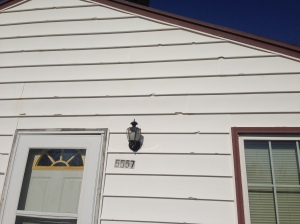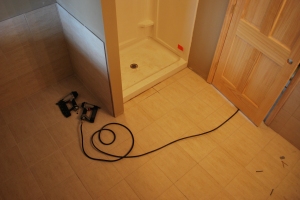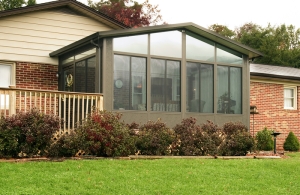As storm season approaches, so do the storm chasers. A majority of roofing contractors in the state of MN and throughout the country live and die with storm damage. Without homeowners filing claims, a majority of these companies would fail to exist. Most have no concept of helping a homeowner through the traditional retail method.
I am sure most of you have had someone knock on your door about the possibility of having storm damage to your home. Ten years ago you could breath after a storm rolled through knowing that in the near future and when you were ready that you would have to find a roofer to take a look at your property. Now its like a circus with every roof jockey out knocking doors within 5-10 minutes after a storm rolls through. These storm chasers know that a majority of people will sign with the first company that knocks on their door. These stormers hope that the homeowner will not check to see if the roofer has the necessary tools to complete the job. In a lot of cases these stomers will promise free incentives if the homeowner signs on the front steps; such as free deductibles, extra work at no cost, gift card or even free flat screen TV (all of which are illegal and are considered insurance fraud).
So what should a homeowner do if their property is hit by a storm.
#1- Breath. Unless your home is hit with softball size hail with 60mph winds, then most of the damage will be cosmetic, meaning that you have time. Don’t sign with the first guy that knocks on your door. Ask around and find a contractor that has been used by a family member or friend.
#2- Call a reputable contractor, preferably one that was referred. Have them come out and inspect your property before filling a claim. Make sure to find someone that has worked with homeowner insurance claims before as to not waste everyone’s time by having the insurance company out if there is no damage.
#3- Call your insurance agent or company. A lot of agents have indirect ties with contractors. Some agents might be a part of a business networking group which has a contractor in the group. That agent could refer the contractor to one of their clients knowing that this contractor is fair, honest and up-front. This helps everyone involved because it can save time if there is no damage.
#4- Keep your eyes open. You will know which neighbors signed 5 minutes after the storm because they are the first ones to get their roofs replaced. Watch as your neighbors roof is being replaced and ask these questions: Are the roofers keeping a clean job site, are they using good quality materials, are they protecting the landscaping, are they keeping safe by adhering to OSHA standards, is the salesman, project manager or owner present? Also keep in mind on how long job takes. Most roofs can be completed in one day. If a job is taking more than one day, then either the crew is inexperienced, unqualified or undermanned. Sometimes contractors will take a 8 man crew and break them into two 4 man crews because they are too busy and can’t keep up. This is not good for you since the your job will take longer and could expose your roof to Mother Nature.
#5- Read the contract. Make sure that you understand what you are signing. Don’t be pressured into signing something the first time or going with the first agreement. Make sure the contract has a local address on it and local phone number (make sure it’s not a pre-paid number used by stormers). Make sure there is a clear dollar amount for the work being completed and a schedule of payments. Sometimes there are supplements that are needed because the insurance company missed or couldn’t see something on the initial inspection. Make sure that the contract has something regarding supplements and that they are only paid to the contractor if the homeowner is reimbursed by the insurance company. The only thing that should be paid out of pocket is the deductible and any kind of upgrades or additional work.
#6- Get a lien waiver. After the job is complete and immediately after the final check is given to the contractor, make sure to get a signed lien waiver. Anyone that furnishes materials or labor can put a lien on your home if they are not paid. Just because you paid the total contract amount doesn’t guarantee that the contractor paid his bills. By receiving a lien waiver, the contractor certifies that all labor and materials have been paid and that no one can come back to you for any outstanding bills. There was a recent story in Illinois where multiple homeowners had liens placed on their homes by the local material supplier. The contractor that completed the work never paid for the materials and since the homeowners hadn’t received a lien waiver the homeowners were legally responsible for the outstanding material invoices.
#7- Ask questions. When a contractor comes to your house make sure to ask how long they have been in business. Ask how long they personally have been a part of that said company. Ask about their knowledge and training and how many years they have been in the business. Make sure they are licensed and that their crew members have their own insurance and workman’s comp. Ask about extended warranties and if they are certified with the shingle manufacturer. Make sure the contractor pulls the necessary permits. If you feel pressured by the contractor then it might be time to call someone else. If you feel like the person is nice but doesn’t really know what they are talking about then its time to call someone else. If you someone tells you that getting your insurance company to pay for a new roof is “guaranteed, slam dunk, or in the bag” please be cautious. Nothing is ever guaranteed and most times a contractor will tell you that just to get the claim filed, regardless if there is damage or not.
Hopefully these pointers come in handy. The worst thing for us is getting called out to someone’s home where they had been ripped off and are looking for help. There are a lot of over qualified contractors but there are also a lot of bad contractors. Your home is a huge investment and nothing should be done to your home while standing on the front steps. Take your time and find the perfect fit. If you would like help with your insurance claim or any other project, then please feel free to give us a call @ 763.238.1632 or email at info@lermn.com














